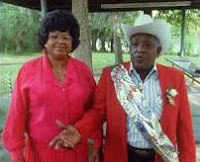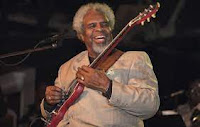 Away from the urban environment of New Orleans, he was playing with his band The Magic Sounds (or sometimes Majic), a down-home style primarily intended to entertain rural people of the Southern Louisiana back-country . No keyboard, no horns either, just a bass, one and later two guitars, rubboard and drums, and himself on accordion. A small combo, a lot of songs in Creole French, a music to be danced.
Away from the urban environment of New Orleans, he was playing with his band The Magic Sounds (or sometimes Majic), a down-home style primarily intended to entertain rural people of the Southern Louisiana back-country . No keyboard, no horns either, just a bass, one and later two guitars, rubboard and drums, and himself on accordion. A small combo, a lot of songs in Creole French, a music to be danced.
 |
| First Zydeco record in history ? |
 |
| The Creole Cowboy |
 |
| Boozoo and his wife Leona |
During this long break, free from the serious competitor that Boozoo could have been, Chenier's career which started the same year as Boozoo (1954), took off : he reached a national and international stature and was crowned “King of Zydeco”.
 |
| Beau Jocque (left) and Boozoo |
It's only in 1984 that Boozoo agreed to return to music, encouraged by his wife Lena, particularly after hearing on the radio an ad announcing a concert by a fake Boozoo Chavis !
After Clifton Chenier's death in 1987, Beau Jocque (1953-1999) became his main challenger, but Boozoo “officially” inherited Chenier's “King of Zydeco” crown in New Orleans in 1993. Since his comeback, famous for his distinctive white Stetson hat, that earned him his “Creole cowboy” moniker, and his colored accordions, he released about fifteen albums, “Down Home On Dog Hill” (2001) being his last opus.
 |
| Father and sons |
Poncho then took over, managing to get the band perform a tribute performance to Boozoo at the 2002 New Orleans Jazz and Heritage Festival.
 |
| Boozoo at home in the early days |
 |
| Boozoo & Carlton "Guitar" Thomas |
The album has a definite vintage rural sound, often melancholic. Ignoring the new trends of the genre, Boozoo sticks to traditional Zydeco as it was performed in Saturday night dances, balls, fish-fries, crawfish parties or trail-rides in South Louisiana : a music to dance to. He mixes old waltzes and two-steps, swamp blues and pinches of country spice.
With his deep slightly raspy unmistakable voice, often hypnotic accordion phrases and large use of Creole French lyrics, Boozoo could be considered as a folk musician in the sense that he played a genre originally specific to a precise region and population.
 |
| Great bassist Classie Ballou |
But this “Zydeco” originally made of waltzes and two-steps, and closely linked to his Cajun musical cousin, was never hermetic to outside influences : the blues came down along the river from Mississippi and Arkansas, the country music from neighboring Texas, and later the Rhythm'n'Blues from New Orleans.
 |
| Anthony Charles Chavis |
 |
| 1993: New King of Zydeco |
Blues is deeply flavoring songs like “Oh Black Gal” (though blended with two-step), “I'm Going To The Country To Get Me A Mojo Hand” and “Big Leg Woman” (with really nice guitar), while a track as “You Used To Call Me” has a strong Country music taste.
More tender moments are featured with the catchy laid-back rolling beat of the opening track “Lula Lula Don't You Go To Bingo” or melancholic waltz ballads like “Oh Bye Mon Neg” and “Oh Ya Oh Ya My Foot Hurts”.
Rhythm to laugh and dance, melancholic ballads for tender slows, an album carrying a feeling of nostalgia about a form of traditional rural Zydeco.
 The opening track, “Do It All Night”, gives the tone : syncopated accordion, pulsing bass from the great Ballou, repetitive basic “lyrics” designed less to tell a story than for rhythmical purpose, punctuated by regular interjections as “hey toi!”, “'tention!”, “eh là-bas!”, “wahouh!”, and the most frequent : “yeah you right!”
The opening track, “Do It All Night”, gives the tone : syncopated accordion, pulsing bass from the great Ballou, repetitive basic “lyrics” designed less to tell a story than for rhythmical purpose, punctuated by regular interjections as “hey toi!”, “'tention!”, “eh là-bas!”, “wahouh!”, and the most frequent : “yeah you right!”
Songs like “Suzy Q” or “Motor Dude Special” are reduced to simple repeated choruses, a more special habit on the titles sung in English, delivering a little more elaborated lyrics on the French Creole tracks.
 |
| Rural roots... Unknown Creole accordion player around 1850 |
Like his famous elders, particularly Clifton Chenier, Boozoo perpetuated the Creole French culture through his songs, but also incorporated blues on numbers like “Tell Me What's The Matter”, his 1954 hit “Paper In My Shoe” half in English half in Creole French, or “Worried Life Blues” in the final medley.
Still, Boozoo had kept the rural roots of Zydeco in his music and on a song like “Johnnie Billy Goat”, even African influences.
 |
| With Anthony Charles |
Boozoo and Anthony Charles show real talent as entertainers, often addressing the public with their speedy vocal output, even once to warn that a car has left his lights on. Boozoo who often refers to himself (“Boozoo this”, “Boozoo that”), and even sings “Don't Worry About Boozoo”, is keeping the audience under his spell with pure dancing two-steps like “Grand Mary's Two Step” or “Boozoo's Breakdown”.
On top form in front of “their” public, Boozoo and his men recorded on that night of September 1993 one the best live Zydeco album. Hey toi ! Fais 'tention ! Here comes the atomic bomb of Lake Charles !
 For the rest, it's the same good time dancing Zydeco carried by Ballou's killing bass, and the same good ol' Boozoo with just more systematic interjections and mischievous comments shouted by Anthony Charles in the background.
For the rest, it's the same good time dancing Zydeco carried by Ballou's killing bass, and the same good ol' Boozoo with just more systematic interjections and mischievous comments shouted by Anthony Charles in the background.
 The album features some attractive two-step like the opening “Dance All Night”, “Who Stole My Monkey”, “I Went To The Dance”, a more funky number like “Oh Yeah”, the hypnotic “Ay, Cayenne”, the revisited rock versions of “Baby Please Don't Go” and “Bottle Up And Go”, or the lively traditional-sounding “Allons A Lafayette”.
The album features some attractive two-step like the opening “Dance All Night”, “Who Stole My Monkey”, “I Went To The Dance”, a more funky number like “Oh Yeah”, the hypnotic “Ay, Cayenne”, the revisited rock versions of “Baby Please Don't Go” and “Bottle Up And Go”, or the lively traditional-sounding “Allons A Lafayette”.
 “I'm Going Away To Stay”, “I Want To Go Home”, “Lucille” and the melancholic “Valse De Derniere Fois”, bring a more moody feel.
“I'm Going Away To Stay”, “I Want To Go Home”, “Lucille” and the melancholic “Valse De Derniere Fois”, bring a more moody feel.
But the highlights of this album are the two closing tracks : re-recorded versions of both sides of an old single banned from radio broadcast at the time, “LA. Women Love Uncle Bud”/“Deacon Jones”, which used to be sold “under the counter” in regional record shops. This couple of tracks earned “Who Stole My Monkey”, the album, the “honor” of being the first Zydeco record to carry a parental warning label due to offensive lyrics !
 I repeat, each of the 13 tracks, from “Tell Me What You Want” to “Henry Martin Two Step”, is a fine piece of Zydeco. It is a matter of personal taste for each one to determine which songs are more appealing to his/her ears.
I repeat, each of the 13 tracks, from “Tell Me What You Want” to “Henry Martin Two Step”, is a fine piece of Zydeco. It is a matter of personal taste for each one to determine which songs are more appealing to his/her ears.
 Personally, I have a soft spot for the opening blues “Keep Your Dress Tail Down”, spiced by the great guitar and fiddle work of Landreth and Greely, for “Negre Est Pas Là” which sounds like an old French bourrée, for “'Tite Fille” whose melancholic mood is enhanced by David Greely's fiddle and Landreth' guitar, for the mischievous double-entendre lyrics and irresistible dancing rhythm of “La Poule Pend P'us” (the hen doesn't lay eggs anymore...), for the nice accordion-fiddle duet on “Henry Martin Two Step”, and finally for the excellent Classie Ballou on bass, for Greely's violin, and particularly Landreth who enlighten the whole album with a convincing slide perfectly accorded to Boozoo hypnotic one-chord tunes and rough hoarse voice. (Note that the sad “Crying Blues” appears as such on the cover track-list and as “Prison Blues” in the credits on... the next page of the booklet !)
Personally, I have a soft spot for the opening blues “Keep Your Dress Tail Down”, spiced by the great guitar and fiddle work of Landreth and Greely, for “Negre Est Pas Là” which sounds like an old French bourrée, for “'Tite Fille” whose melancholic mood is enhanced by David Greely's fiddle and Landreth' guitar, for the mischievous double-entendre lyrics and irresistible dancing rhythm of “La Poule Pend P'us” (the hen doesn't lay eggs anymore...), for the nice accordion-fiddle duet on “Henry Martin Two Step”, and finally for the excellent Classie Ballou on bass, for Greely's violin, and particularly Landreth who enlighten the whole album with a convincing slide perfectly accorded to Boozoo hypnotic one-chord tunes and rough hoarse voice. (Note that the sad “Crying Blues” appears as such on the cover track-list and as “Prison Blues” in the credits on... the next page of the booklet !)
A great refreshing return to the original rustic authenticity of dancing Zydeco. ■
 ► Fortunately, this full performance at the Zydeco Festival 1996 in Plaisance, LA, gives a pretty good taste of Boozoo live : https://youtu.be/ttyZxzqm6HM
► Fortunately, this full performance at the Zydeco Festival 1996 in Plaisance, LA, gives a pretty good taste of Boozoo live : https://youtu.be/ttyZxzqm6HM |
| Boozoo Chavis, 1930-2001 |







No comments:
Post a Comment